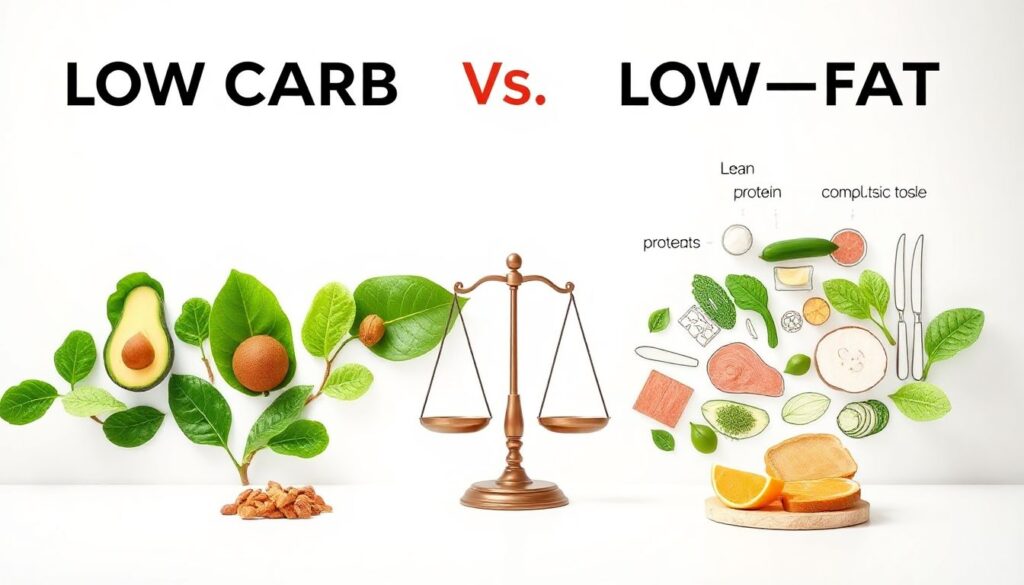Low-Carb vs Low-Fat: Which Diet Reigns Supreme for Weight Loss?

Low-Carb vs Low-Fat:
Losing weight often feels like a puzzle with missing pieces. Everyone struggles with what to eat, facing so much conflicting advice. Two long-standing diet approaches, low-carbohydrate and low-fat eating, always spark fierce debate. Which path truly leads to better, lasting weight loss?
Both diet plans promise results by changing how you fuel your body. A low-carb diet cuts back on sugars and starches, pushing your body to burn fat instead. Low-fat diets, on the other hand, limit fatty foods to reduce calorie intake. Each has its own science, history, and a loyal following.
This article explores how these diets work at a basic level. You will learn about their benefits and downsides. We will also look at what real studies say about their effectiveness. Finally, you will get help choosing the right approach for your own weight loss journey.
Understanding the Science: How Do These Diets Work?
Knowing the science behind each eating plan helps you make smart choices. Both low-carb and low-fat diets change how your body processes food. They aim to create a calorie deficit, which is key for dropping pounds.
Low-Carbohydrate Diets: The Fat-Burning Advantage

Low-carb diets focus on greatly cutting down carbohydrates. This shift makes your body change its main fuel source. Instead of burning glucose from carbs, it starts burning fat.
The Ketogenic Connection
When you limit carbs severely, your body enters a state called ketosis. During ketosis, your liver makes ketones from fat. These ketones then serve as the main fuel for your brain and body. This process makes your body very efficient at burning stored fat.
Impact on Blood Sugar and Insulin
Eating fewer carbs also stabilizes your blood sugar levels. High carb intake can lead to quick spikes in blood sugar, followed by a rush of insulin. Insulin helps store fat, so keeping it low can help your body release and burn fat more easily. Many people feel more steady energy and less hunger on this plan.
Macronutrient Ratios
A typical low-carb diet looks different from standard eating. It usually means eating a lot of healthy fats, a moderate amount of protein, and very few carbohydrates. For example, less than 50 grams of carbs a day is common for ketosis. Your food choices will center around meats, fish, eggs, and non-starchy vegetables.
Low-Fat Diets: Cutting Calories, Not Necessarily Carbs

Low-fat diets have been a popular weight loss strategy for decades. This approach focuses on reducing the total amount of fat consumed. The idea is simple: fat has more calories per gram than carbs or protein.
The Calorie Control Principle
By cutting back on fats, you naturally lower your overall calorie intake. This calorie reduction is the primary way low-fat diets aim for weight loss. The focus is often on choosing lean protein and lots of fruits and vegetables. These foods are generally lower in calories.
Satiety and Fiber
Many low-fat plans encourage eating plenty of fruits, vegetables, and whole grains. These foods are rich in fiber. Fiber helps you feel full longer, which can stop you from overeating. It also aids digestion and keeps your gut healthy.
Macronutrient Ratios
In a low-fat diet, a significant portion of your calories comes from carbohydrates. Protein intake stays moderate to support muscle health. Fat intake is kept much lower than in other diets. This structure often includes foods like lean meats, dairy, whole grains, and a wide variety of plant-based options.

The Pros and Cons: A Balanced Perspective
Both low-carb and low-fat diets offer unique benefits and present their own challenges. Understanding these can help you decide which might fit your needs better. No diet is perfect for everyone.
Benefits of Low-Carb Eating
Many people find success with low-carb eating, especially in the beginning. It can bring quick changes to your body. These changes often feel motivating and encouraging.
Rapid Initial Weight Loss
One of the biggest draws of low-carb diets is the quick weight loss seen early on. This initial drop is often due to losing water weight. When you cut carbs, your body uses up its stored glycogen, which holds water. This can lead to a few pounds disappearing fast.
Improved Blood Markers
Studies often show that low-carb diets can improve certain health markers. People might see lower triglyceride levels and higher HDL (“good”) cholesterol. Blood sugar control can also get better, which is helpful for those managing diabetes. These changes point to improved metabolic health.
Appetite Suppression
Eating more protein and fat, as in low-carb diets, tends to make you feel fuller. These macronutrients take longer to digest. This can lead to less hunger between meals and fewer cravings. It makes it easier to stick to a calorie deficit without feeling deprived.
Drawbacks of Low-Carb Diets
Despite the benefits, low-carb eating comes with potential downsides. These can range from temporary discomfort to long-term issues. It is important to know what to expect.
“Keto Flu” and Side Effects
Many people starting a very low-carb diet experience “keto flu.” This phase includes symptoms like fatigue, headaches, dizziness, and irritability. Digestive problems, such as constipation, are also common. These side effects usually pass as your body adjusts.
Sustainability and Social Challenges
Sticking to a strict low-carb diet for a long time can be hard. Many common foods like bread, pasta, and certain fruits are off-limits. This can make eating out or social gatherings tricky. Long-term adherence often proves difficult for some individuals.
Nutrient Deficiencies
Without careful planning, low-carb diets might lead to nutrient gaps. You could miss out on fiber, which is common in grains and some fruits. Also, certain vitamins and minerals found in a wider variety of plant foods might be lower. This means paying attention to diverse food choices.
Benefits of Low-Fat Eating
Low-fat diets also have their own set of advantages. They align with many general health recommendations. This can make them a natural fit for some people.
Heart Health Focus
Limiting saturated and trans fats is a core part of low-fat eating. This approach can be good for your heart. Reducing these fats often helps lower LDL (“bad”) cholesterol, which is a risk factor for heart disease. It supports overall cardiovascular well-being.
Easier to Follow for Some
For many, a low-fat diet might feel less restrictive than low-carb. It often allows for a broader range of foods, including fruits, grains, and legumes. This flexibility can make it easier to stick to for some people. It also fits well with many cultural eating patterns.
Potential for High Fiber Intake
Emphasizing whole grains, fruits, and vegetables naturally boosts your fiber intake. A high-fiber diet promotes healthy digestion. It also helps manage blood sugar levels and can contribute to feelings of fullness. This can be a strong point for gut health.
Drawbacks of Low-Fat Diets
Just like low-carb, the low-fat approach has its challenges. Some issues come from how people interpret the diet. Others are tied to its basic principles.
Risk of Processed Foods
A big pitfall is reaching for “low-fat” processed foods. Many items labeled “low-fat” or “fat-free” often have more sugar and refined carbohydrates. Food makers add these to improve taste when fat is removed. These added ingredients can work against weight loss and overall health goals.
Potential for Fatigue
If fat intake is too low, some individuals may experience reduced energy levels. Fats are an important source of energy. They also help your body absorb fat-soluble vitamins. A very strict low-fat diet might leave you feeling sluggish.
May Not Address Underlying Hormonal Issues
For some people, particularly those with insulin resistance, cutting only fat might not be enough. If the body struggles to process carbohydrates effectively, simply reducing fat won’t fix the underlying problem. It’s often about balancing all macronutrients correctly.
Evidence in Practice: What Do Studies Say?
Scientific research offers important clues about which diet works best. Many studies have compared low-carb and low-fat approaches. We can learn a lot from their findings.
Comparative Studies and Meta-Analyses
Researchers have looked closely at both diets over time. They want to see which one delivers better results. Large studies help us understand the overall picture.
Weight Loss Outcomes
Many studies show that both low-carb and low-fat diets can lead to weight loss. Often, in the short term (6-12 months), low-carb diets might show slightly faster initial weight loss. However, after a year or more, the weight loss differences between the two often become less significant. The DIETFITS study, for example, found no major difference in weight loss between healthy low-fat and healthy low-carb diets over 12 months.
Metabolic Health Markers
Both diets can improve metabolic health markers. Low-carb diets often lead to better triglyceride levels and improved blood sugar control. Low-fat diets, especially those emphasizing whole plant foods, can lower LDL cholesterol. The specific benefits vary depending on the diet’s quality and the individual’s health status.
Long-Term Adherence and Success Rates
The real challenge for any diet is keeping the weight off. This is where adherence plays a huge role. How long someone can stick with a diet matters most for success.
The “Adherence Factor”
Research consistently shows that the diet you can follow consistently is the one that works best long-term. If a diet feels too hard or restrictive, people stop doing it. This means the best diet for you is one that fits your lifestyle and preferences. It is not always the one with the fastest initial results.
Individual Variability
People respond to diets in different ways. Some thrive on a low-carb approach, feeling energetic and satisfied. Others feel better with a low-fat, higher-carb plan. Genetics, metabolism, and even gut bacteria can affect how your body handles different foods. What works for one person might not work for another.
Making the Choice: Which Diet is Right for You?
Choosing between low-carb and low-fat should not be a rushed decision. It requires thinking about your own body, your life, and your health goals. There is no single “best” diet for everyone.
Factors to Consider
Think about what truly matters to you and your daily life. Your success often hinges on how well a diet fits into your world. This personalization is important.
Personal Preferences and Lifestyle
Do you love bread and pasta? Or do you prefer meat and cheese? Your food preferences are key. A diet you dislike will be hard to maintain. Also, consider your cooking habits, family meals, and social life. A diet that causes constant stress is probably not the right one.
Health Conditions and Goals
Certain health issues might guide your choice. For example, people with type 2 diabetes often see good results with low-carb diets due to better blood sugar control. If heart disease is a concern, a well-planned low-fat diet focusing on whole foods could be beneficial. Always consider your specific health needs.
Genetics and Metabolism
Your body’s unique makeup can influence how you react to different foods. Some people might process carbs more efficiently, while others might do better with more fat. While not always easy to test, listening to your body’s signals helps. How do you feel after certain meals?
Expert Opinions and Recommendations
General health advice can provide a good starting point. However, personalized guidance is often the most effective. These experts offer valuable insights.
Consensus from Health Organizations
Most major health organizations promote a balanced diet. They suggest plenty of fruits, vegetables, lean proteins, and whole grains. They also advise limiting processed foods, added sugars, and unhealthy fats. These are common threads found in both diet approaches when done well.
When to Seek Professional Guidance
It’s a smart move to talk with a doctor or a registered dietitian before starting any major diet change. They can assess your health. They can also help you create a meal plan that is safe, effective, and tailored just for you. This guidance can prevent nutrient deficiencies and ensure you meet your health goals safely.
Actionable Tips for Success
No matter which diet you choose, some practical steps can boost your chances of success. These tips focus on making healthy choices and staying on track. Small changes can lead to big results.
Starting Your Low-Carb Journey
If you lean towards a low-carb lifestyle, start smart. Ease into it to help your body adjust. You want to avoid common beginner mistakes.
- Tip 1: Slowly cut down on refined carbs like white bread, sugary drinks, and pastries. Replace them with healthier options.
- Tip 2: Focus on eating non-starchy vegetables such as leafy greens, broccoli, and peppers. Pair these with lean proteins like chicken, fish, or eggs, and healthy fats from avocados, nuts, and olive oil.
- Tip 3: Drink plenty of water. Pay attention to your electrolyte intake, as low-carb diets can sometimes deplete them, causing “keto flu” symptoms.
Starting Your Low-Fat Journey
If a low-fat diet seems right for you, plan your meals carefully. The goal is to reduce unhealthy fats while still getting enough nutrients. Your focus is on lean choices.
- Tip 1: Choose lean protein sources, such as skinless poultry, fish, beans, and lentils. Limit visible fats when cooking and preparing food.
- Tip 2: Prioritize whole grains like oats, brown rice, and whole wheat bread. Eat plenty of fruits and vegetables at every meal for fiber and vitamins.
- Tip 3: Be careful with products labeled “low-fat.” Always check the nutrition labels for hidden sugars and refined carbs. Choose naturally low-fat, whole foods instead.
General Strategies for Both
Certain strategies work well no matter your diet choice. These universal tips support any weight loss plan. They help create a foundation for lasting health.
- Tip 1: Portion control remains critical regardless of whether you are low-carb or low-fat. Eating too much of any food, even healthy ones, can hinder weight loss.
- Tip 2: Prioritize whole, unprocessed foods whenever possible. These foods are generally more nutrient-dense and satisfying than their processed counterparts.
- Tip 3: Combine dietary changes with regular physical activity. Exercise helps burn calories, build muscle, and improve overall health.
- Tip 4: Track your progress and listen to your body’s signals. Pay attention to how you feel, your energy levels, and your weight changes. Adjust your diet as needed.
Conclusion
The debate between low-carb and low-fat diets for weight loss is complex. It shows there isn’t one perfect answer for everyone. Both approaches have scientific backing and can lead to results. The “best” diet is truly the one you can stick with consistently. This means it fits your lifestyle, tastes, and health needs.
Sustainable weight loss almost always comes from a balanced approach. This means eating mostly whole foods, controlling your portion sizes, and moving your body regularly. It is about creating healthy habits you can maintain, not just quick fixes.
Explore what works best for you with an open mind. Always consider talking with a doctor or a registered dietitian. They can provide personalized advice for your unique body. Your journey to better health should always prioritize overall well-being over strict diet labels.

